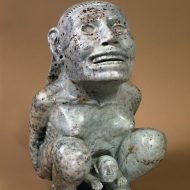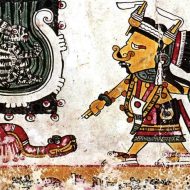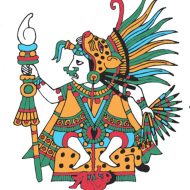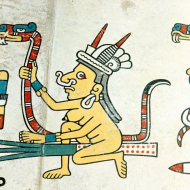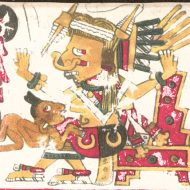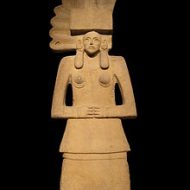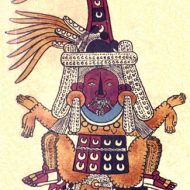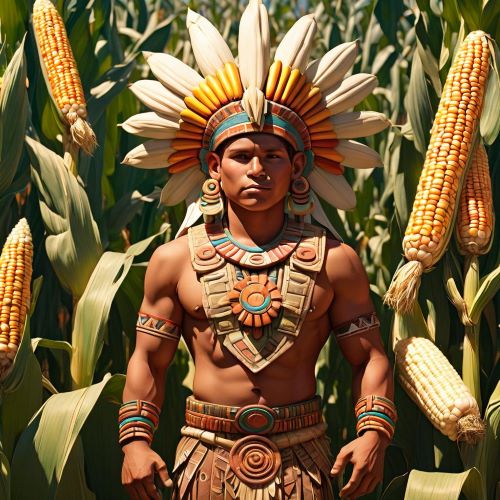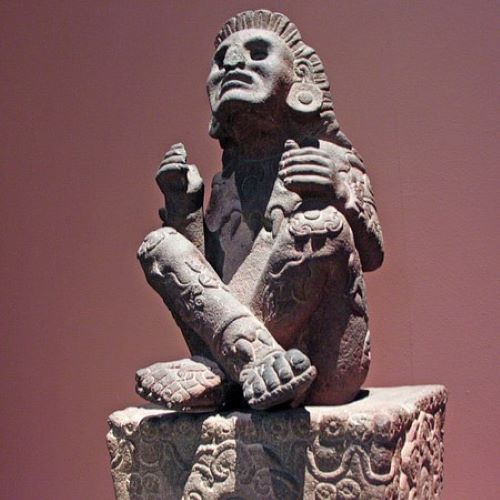Tlazolteotl : Goddess of Sin
Listen
At a glance
| Description | |
|---|---|
| Origin | Aztec Mythology |
| Classification | Gods |
| Family Members | Omecihuatl (Father), Cinteotl (Daughter) |
| Region | Mexico |
| Associated With | Lust, Sin, Purification, Filth Eating |
Tlazolteotl
Introduction
Tlazolteotl, a prominent figure in Aztec mythology, plays a multifaceted role within Aztec society. Her influence spans various domains of life, encompassing aspects from purification to fertility. Originating from the Gulf lowlands of Huaxteca, Tlazolteotl is a nuanced earth-mother goddess, known by the epithet “Filth-Eater.” She holds the dual titles of the goddess of sin and purification, weaving the threads of temptation and forgiveness alike. In her embrace of both darkness and light, Tlazolteotl emerges as a complex counterpart to the more easily categorized deities found in the expansive Aztec pantheon.
Physical Traits
Tlazolteotl’s depictions exhibit a range of images, mirroring her multifaceted nature. In some instances, she manifests as a mature woman adorned with a headdress crafted from raw cotton, symbolizing her role as a fate-weaver. The skulls adorning her necklace represent death and transformation, while her skirt, fashioned from the skin of a flayed victim, underscores her connection to sacrifice. Alternately, she takes on a younger and more seductive form, enticing mortals with captivating beauty and alluring whispers.
Tlazolteotl is commonly portrayed with blackened lips and teeth, donning a distinctive conical headdress. Certain representations depict her in a birthing posture or wearing the skin of a sacrificial victim, each imagery symbolizing her profound association with the cyclical nature of life, death, and rebirth. These diverse depictions collectively capture the complexity of Tlazolteotl’s character, showcasing her as a deity intimately intertwined with the intricate dance of existence.
Family
Tlazolteotl, born of Omecihuatl, emerges as a deity with a complex lineage. Alongside her, she has divine siblings collectively known as the Nauhtzonteteo, a pantheon comprising 1,600 gods. Among her significant roles, Tlazolteotl is the revered mother of Cinteotl, the god associated with corn.
The intricacy of Tlazolteotl’s lineage becomes apparent through varying accounts. Some sources posit her as the mother of all gods, including the maize deity Cinteotl. Alternatively, other narratives link her to a quartet of sister goddesses, each embodying distinct facets of her intricate nature. Ixcuina, known as “She of Two Faces,” encapsulates Tlazolteotl’s inherent duality, while Xocotzin, aptly named “Little Flower,” mirrors her youth and allure. The diverse tales surrounding Tlazolteotl’s familial connections contribute to the rich tapestry of her mythological character.
Other names
Tlazolteotl, the multifaceted deity of Aztec mythology, is recognized by three alternate names: Tlahēlcuāni, translating to “she who eats tlahēlli or filthy excrescence [sin],” Tlazōlmiquiztli, signifying “the death caused by lust,” and Ixcuina or Ixcuinan. These diverse names encapsulate the breadth of concepts embodied by Tlazolteotl.
“Tlahēlcuāni,” or “She who eats filth,” underscores her unique power to absorb and purify sin. Meanwhile, “Tlazolmiquiztli,” translated as “Death Caused by Lust,” delves into her association with transgressive desires and the potential consequences they may yield. On another note, she is also referred to as “Ixcuinan,” the “Cotton Deity,” symbolizing her connection to weaving, fertility, and transformative processes. Each of these names unveils a distinctive facet of Tlazolteotl’s complex and multifaceted essence.
Powers and Abilities
Tlazolteotl is a deity encompassing diverse realms, representing sexuality, vice, purification, steam baths, lust, filth, and serving as a patroness of adulterers. Her influence is paradoxical, as she inspires both carnal desire and sinful behavior while simultaneously offering absolution and forgiveness. Additionally, Tlazolteotl is intricately linked to lunar and agricultural attributes, symbolized by her association with the jaguar and the ritualistic calendar.
In her role as Tlazolteotl-Tlaelcuani, the forgiver of sins, her clergy actively engages in hearing confessions and providing absolution. Tlazolteotl’s dominion extends across both the material and the spiritual realms. She ignites desires within mortals, weaving threads of temptation that lead to transgressions. Yet, she also facilitates absolution through confession and ritualized cleansing, especially in the context of sweat baths.
Tlazolteotl’s power is manifested in the realms of steam and filth, both in the literal and metaphorical sense, showcasing her unique ability to transform impurity into purity. As a deity presiding over childbirth, she guides new life into the world, simultaneously weaving the threads of fate for newborns. The intricate duality within Tlazolteotl’s influence reflects the complex interplay between desire, sin, purification, and the cyclical nature of life.
Modern Day Influence
Tlazolteotl’s influence transcends the confines of museums and ancient codices, resonating as a vibrant reminder that humanity grapples with enduring questions – the complexities of desire, the weight of sin, and the prospect of redemption. In a world marked by increasing moral absolutes and fragmentation, Tlazolteotl’s embrace of paradox provides a space for nuanced reflection and compassionate understanding. Her continued captivation lies in her enduring power and significance within contemporary culture. Ancient artwork and iconography pay homage to her divine attributes, ensuring that Tlazolteotl’s unique role among Aztec goddesses permeates the influence of other deities and carries symbolic weight in matters of fertility and creation.
Related Images
Frequently Asked Questions
What is lorem Ipsum?
I am text block. Click edit button to change this text. Lorem ipsum dolor sit amet, consectetur adipiscing elit. Ut elit tellus, luctus nec ullamcorper mattis, pulvinar dapibus leo.
What is lorem Ipsum?
I am text block. Click edit button to change this text. Lorem ipsum dolor sit amet, consectetur adipiscing elit. Ut elit tellus, luctus nec ullamcorper mattis, pulvinar dapibus leo.
What is lorem Ipsum?
I am text block. Click edit button to change this text. Lorem ipsum dolor sit amet, consectetur adipiscing elit. Ut elit tellus, luctus nec ullamcorper mattis, pulvinar dapibus leo.
What is lorem Ipsum?
I am text block. Click edit button to change this text. Lorem ipsum dolor sit amet, consectetur adipiscing elit. Ut elit tellus, luctus nec ullamcorper mattis, pulvinar dapibus leo.
What is lorem Ipsum?
I am text block. Click edit button to change this text. Lorem ipsum dolor sit amet, consectetur adipiscing elit. Ut elit tellus, luctus nec ullamcorper mattis, pulvinar dapibus leo.

